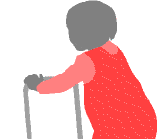Wobbly Babies: Smarter Than They Look?
Toddlers can make quick decisions about when to use a handrail while crossing a bridge.
By Emily Sohn
Strolling across a bridge is no big deal if the bridge is wide and solid. A wobbly, perilously narrow bridge over a deep chasm is another matter entirely. You might very well reach for the handrail to help you get across.
It turns out that toddlers can also make quick decisions about when to use a handrail in the face of various walking challenges. That kind of behavior is a simple example of using tools, say researchers from New York who studied toddlers crossing bridges. Tool use is one classic example of human intelligence.
 |
|
Grabbing a handrail or some other support helps toddlers get to where they want to go. |
Twenty-four boys and 24 girls participated in the experiment. The children were 16 months old. Most had been walking for about 4 months.
Each kid had a series of chances to cross a bridge from one platform to another. Some bridges were wide. Others were narrow. Half of the bridges had a handrail on one side.
When given a choice, the babies always walked across wide bridges, ignoring handrails even if they were there. The kids avoided narrow bridges without handrails.
Bravely, the toddlers often attempted to cross narrow bridges with handrails. In these cases, the shaky-legged walkers would touch the handrail and grab it with their hands. Then, the kids would slow down and switch their footing to move sideways instead of frontward.
The babies used the handrail like a tool, the researchers say. That might be one baby step closer to prying the lid off a cookie jar.
Here’s another interesting thing: Unlike their parents, the babies didn’t grumble or swear when they stumbled.—E. Sohn
Going Deeper:
Bower, Bruce. 2003. Toddlers ride rail to tool use. Science News 163(June 14):380-381. Available at http://www.sciencenews.org/20030614/note12.asp .







